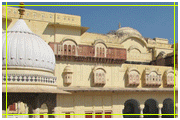

- Rajasthan
- Kerala
- Maharastra
- Tamilnadu



 City : Alwar
City : AlwarLocation : West India
Language : Rajasthani, Hindi.
When to Visit : Around the year.
About Alwar
Alwar is famous for its scenic landscape.
Alwar is a city in the Rajasthan state of western India. It is the administrative headquarters of Alwar District, and was formerly the capital of the princely state of Alwar or Ulwar in British India. The city is located around 160 km south of Delhi, and around 150 km north of Jaipur (Capital of Rajasthan).
Alwar is a city in the Rajasthan state of western India. It is the administrative headquarters of Alwar District, and was formerly the capital of the princely state of Alwar or Ulwar in British India. The city is located around 160 km south of Delhi, and around 150 km north of Jaipur (Capital of Rajasthan).
History
"Alwar" was formerly known as "Ulwar". This placed it in last position in alphabetically ordered lists, so a king renamed it to "Alwar" to bring it to the top. The princely state of Alwar was founded by Pratap Singh, a Rajput of the Kachwaha lineage, in the second half of the 18th century. His adopted son, Bakhtawar Singh, aided the British against the Marathas. After the battle of Laswari (1803), Alwar became the first state of Rajputana to sign a treaty of 'Offensive and Defensive Alliance' with the British East India Company.
A few years later, Bakhtawar Singh ventured an armed incursion into neighbouring Jaipur, the senior Kachwaha state, and the erstwhile overlord of his predecessor. Bakhtawar Singh was defeated; a fresh engagement was made with him by the HEIC, prohibiting him from political intercourse with other states without British consent. During the Sepoy Mutiny of 1857, Raoraja Bane Singh sent a force comprised mainly of Muslims and Rajputs, to relieve the British garrison in Agra. The Muslims deserted and the rest were defeated by the rebels. Pran Sukh Yadav, who fought beside Rao Tula Ram of Rewari in 1857, settled along with the kinsmen of dead soldiers at Village Nihalpura, Behror Tehsil, of Alwar District.
Following the independence of India in 1947, Alwar acceded unto the dominion of India. On March 18, 1948, the state merged with three neighbouring princely states (Bharatpur, Dholpur and Karauli) to form the Matsya Union. This union in turn merged unto the Union of India. On May 15, 1949, it was united with certain other princely states and the territory of Ajmer to form the present-day Indian state of Rajasthan.
Jai Dayal Yadav and Prime Minister of Matsya Union Shobha Ram Kumawat played a vital role in bringing education to the rural areas of Alwar after independence.
Fair & Festivals
The main festival of Ajmer is the celebration of the Urs held every year in the seventh month (date varies) of the lunar calendar. A number of Qawali (traditional Muslim recital of devotional verse) functions are held within the Dargah or tomb.
Geography
Alwar is located at 27.57° N 76.6° E.[1] It has an average elevation of 271 metres (889 feet).







